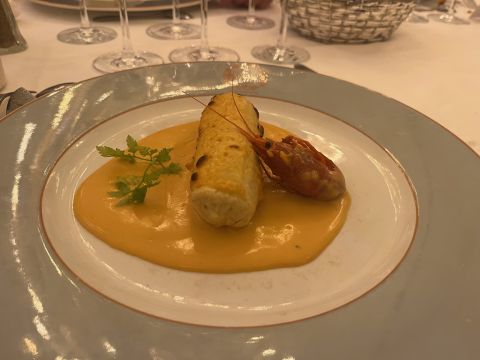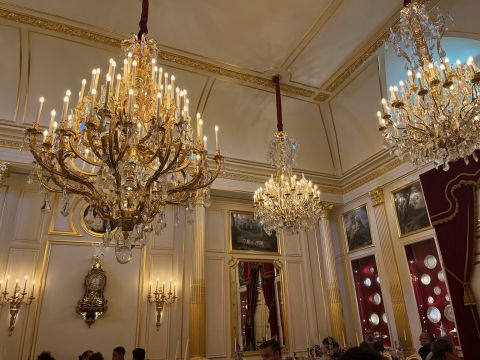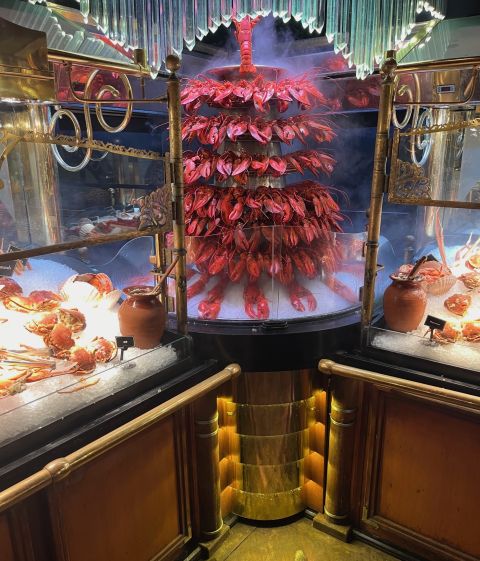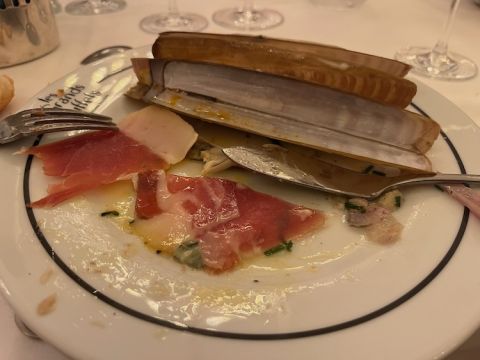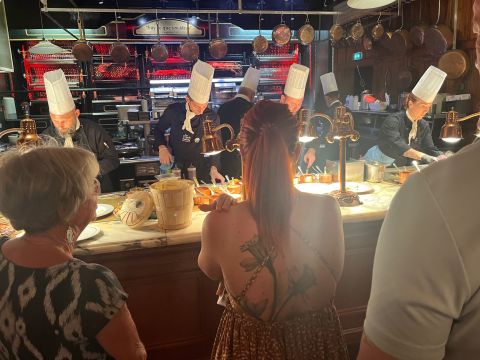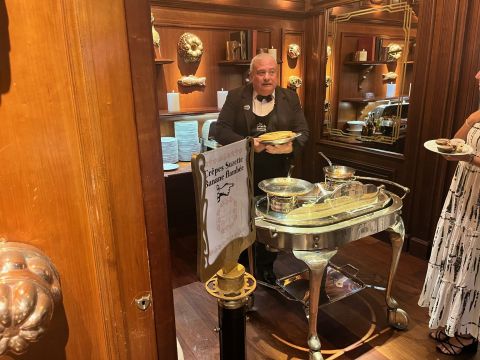Buffet dining in grand style
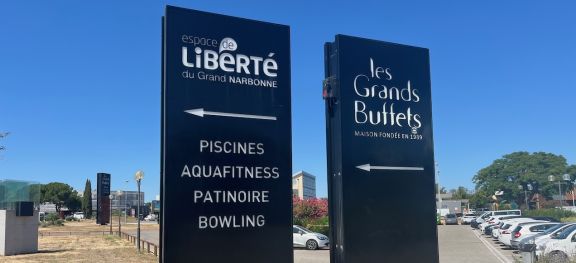
An unlikely location and concept for what The New Yorker described recently as ‘the hottest restaurant in France’.
Les Grands Buffets in Narbonne, whose car park and entrance is shared with users of the city’s leisure centre as you can see above, is unique – unique not just in France but in the rest of the world.
The cooking is excellent. My fish soup, the classic quenelle de brochet sauce Nantua pictured above, the plentiful lobsters, the milk-fed lamb, my dishes of tripe and tête de veau and the vast array of cheeses outnumbered only by the number of desserts on offer proved this. All were served, as the name suggests, at copious buffet stations available, quantity unlimited, for €57.90 per person – including service.
The glass-roofed entrance is admittedly a trial in midsummer heat – perhaps a trial to see whether potential diners are serious about being admitted to the air-conditioned interior. It was swarming with people when we arrived for our 12.30 booking. Most were dressed smartly but some in shorts and T-shirts peeled off to the right for the water park. We were herded left where there were two queues, one for 12.30 reservations, the other for 12.45. Our local friend, who had snagged the booking through a personal connection but had not been there for decades, suggested it was looking like ‘a cross between the Soviet Union and Disneyland’. We waited for about 15 minutes in the not inconsiderable heat until our queue began to move.
The contrast between the outside and the inside of the restaurant could not be greater, and not just in terms of temperature. From the smartly dressed receptionist carefully checking bookings onwards, all the staff are dressed in traditional French black waiting outfits. Just inside the entrance is a large, antique weighing scale, big enough for my 13-year-old grandson to stand on as we left to see that he may have put on two kilos during lunch. Beyond this are showcases containing old-fashioned cooking paraphernalia on the right while most eyes are focused to the left where the dessert section is located. This, even from a distance, is impressive.
Our party of six – myself, JR, our French-born son-in-law and his two sons, 10 and 13, and our Narbonne friend – were then led by a smiling receptionist (the warmth of the waiting staff was notable throughout) via the buffet stations to our table in the Jean de la Fontaine Salon d’Or. This white and gold Louis Something creation is a pure fantasy room with its sparkling chandeliers and mirrors – quite a contrast to the other, much darker dining rooms, and light-years away from the swimming pool and ice rink next door. Sitting in the corner, it was pointed out to me, was the owner, Louis Privat, lunching with his brother Jean. (They seemed to have racked up quite a mountain of shellfish detritus.)
A manageress then appeared, introduced herself (as did our waitress) and proceeded to hand out various pieces of paper including a large-format wine list and, most crucially, a foldout map of the buffet area headed ‘Au Coeur des Grand Buffets’. The wine list is priced in an extremely user-friendly fashion with a good choice of local producers as well as the top French regions. They aim to bolster revenue by encouraging diners to order six-packs of their wines to take away. I watched with pleasure as JR and our friend enjoyed a bottle of Émile Beyer Alsace Riesling, Lieu-Dit St-Jacques 2020 for the princely sum of €26 (less than the one retail listing in France on Wine-searcher.com). The Grands Buffets wine list is impressive – as is their by-the-glass range – as well as their range of eaux-de-vie, which are listed on another piece of paper. Their relationship with Moët allows them to offer Champagne Mercier at €25 a bottle, and they encourage diners to order a sweet wine to go with their six-plus sorts of foie gras from Maison Augusta in the Gers (each serving individually labelled on the plate).
It was time to eat and we set off in the wake of our son-in-law and his sons. The first room with all the first courses was, not surprisingly, the most crowded, with the longest queue at the foie gras station in the centre of the room as most of the clientele on this Monday lunch were French locals for whom, presumably, the plethora of seafood seemed less exotic. (The other source of diners apparently are the numerous Catalans/Spaniards who come up to Narbonne on the TGV from Barcelona, two hours away.) In the corner of the same room is the Cascade de Homard, a tower of cooked and perfectly arranged lobsters hanging waiting to be enjoyed, flanked by other treasures of the sea presented on ice.
I avoided the bigger crowds and decided to put the culinary skills of this restaurant to the test. I began with a herring salad in which the potatoes were perfectly cooked, and a salad of smoked mackerel. I then helped myself to some razor clams and, from a choice of nine breeds of pig, slices of serrano ham. A good, if unconventional, start. The help-yourself model encourages grazing.
I followed this with a large bowl of fish soup topped with excellent rouille and a couple of handfuls of grated Gruyère. What was most impressive was how the staff managed to replenish the food stands almost as quickly as they were being, swiftly, depleted.
It was at this stage of the meal that the restaurant deviated from its title as in the next room there was a full-scale open kitchen with an enormous menu where every dish is cooked to order. Quite simply, guests queue on the left-hand side and announce their chosen dish to a chef who hands them a slip of paper – turbot in the oven, hare à la royale, skate with black butter, for instance – and who then ‘calls’ the order to the kitchen behind him. This is manned by about 15 chefs, dressed in black with white toques, who acknowledge the order. They continue cooking as you step to the right in front of another row of chefs who finish the dish, meat dishes to the right and left and fish dishes in the centre. The main course you have ordered then arrives with one of these chefs who plate the dish, finish it and shout it out. You step forward, hand over your piece of paper, take your plate and happily return to your table.
The quality of this section’s cooking is on a par with the rest and the equivalent of any top French restaurant I have visited. It shows quite how simply a French kitchen can be broken down and, given enough space and labour, easily deliver even the most complicated dish. It was most impressive and gives this restaurant an extra dimension not covered by its name.
En route to this open kitchen are more sections: on the left there is meat galore where they serve côte de boeuf, duck finished showily in the duck press, as at La Tour d’Argent in Paris, milk-fed lamb and pork. Opposite are sections devoted to vegetables (relatively unpopular) and the more traditional meat dishes that were also less crowded, perhaps because it was 35 °C (95 °F) outside: veal kidneys in a madeira sauce, blanquette of veal and a civet of wild boar. Vegetarians would not starve, and would have easy access to the requisite dishes, although they might have difficulty eating €57.90-worth of food.
While our French son-in-law focused on the enormous variety of cheeses, celebrated in the Guinness Book of Records as the widest selection anywhere, we took advantage of the desserts. What was fascinating here, apart from the overall excellent quality of the rum baba and the canelés, was the personnel, who seem to have been chosen from Central Casting. The person in charge of the preparation of the crêpes Suzette looked the part: a grey-haired man who looked as though he had been doing this all his career as he helped a young guest to cover her crepes with sauce from the chocolate fountain.
With our inexpensive bottle of wine, coffee for three and a couple of soft drinks my bill came to €371.20 for five adults and one grandson who was charged half-price (as is their policy for children aged 6–10). It was a steal. Bookings via the website are currently for dates at least six months in advance.
Les Grands Buffets is a high-volume, low-margin business which must have found the COVID period extremely difficult but today seems to have found its own identity. It began life in 1989 as an unmemorable all-you-can-eat cafeteria which we visited after taking the children swimming next door soon after it opened. In 2008 was renamed Les Grands Buffets and then in 2018 underwent a culinary and interior-design upgrade. Privat, who acknowledges in this popular New Yorker article that his aim is to celebrate French cuisine at its most traditional, has continued to add to what is on offer ever since.
I have to conclude by saying that I left Les Grands Buffets full of admiration for Privat. He does not come from a restaurant dynasty but he has so obviously got the bug. He wants to improve all the time and will not be satisfied with anything but the best. He is obviously not in it for the money as, if he were, he would not only increase the prices but be opening similar restaurants around the world. Instead, if you want to enjoy Les Grands Buffets, you will have to visit the sports complex in Narbonne and book far, far ahead. You could work up an appetite by visiting Narbonne’s new Roman museum, Narbo Via, beforehand – or go swimming.
Les Grands Buffets Rond Point de la Liberté, 11100 Narbonne, France; tel: +33 04 68 42 20 01
Every Sunday, Nick writes about restaurants. To stay abreast of his reviews, sign up for our weekly newsletter.
Become a member to view this article and thousands more!
- 15,406 featured articles
- 274,946 wine reviews
- Maps from The World Atlas of Wine, 8th edition (RRP £50)
- The Oxford Companion to Wine, 5th edition (RRP £50)
- Members’ forum
- 15,406 featured articles
- 274,946 wine reviews
- Maps from The World Atlas of Wine, 8th edition (RRP £50)
- The Oxford Companion to Wine, 5th edition (RRP £50)
- Members’ forum
- Commercial use of our Tasting Notes

